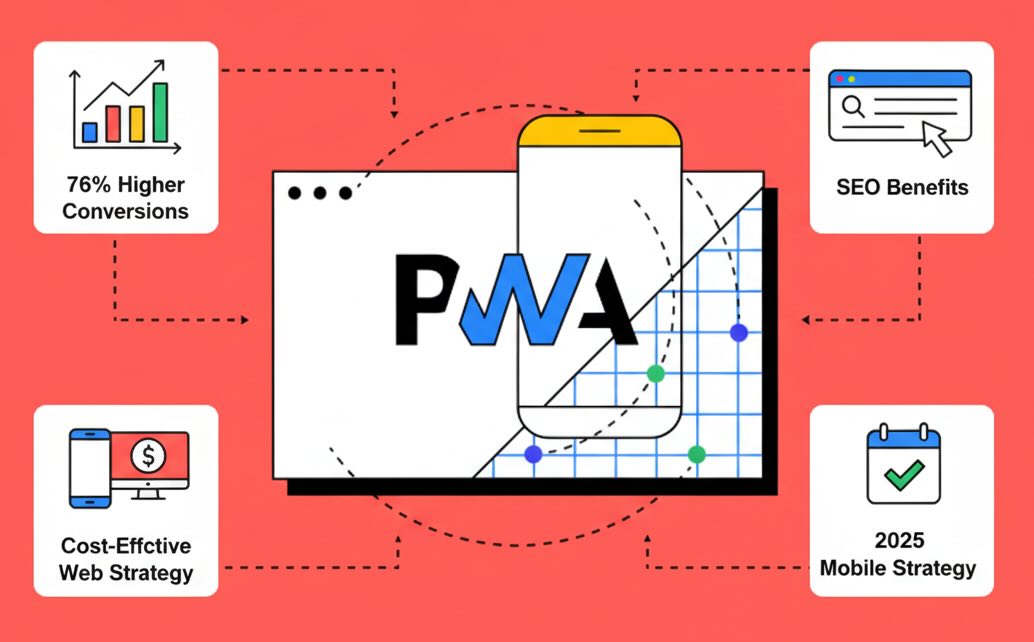Progressive Web Apps (PWAs) have emerged as the dominant mobile strategy for 2025, delivering a remarkable 76% higher conversion rate compared to traditional websites while offering superior SEO benefits that native apps cannot match. Major brands including Alibaba, Starbucks, and Pinterest have reported dramatic performance improvements, with Starbucks seeing double the daily active users after implementing their PWA compared to their native application.
The fundamental advantage lies in PWA’s unique combination of app-like functionality with web accessibility, enabling search engine indexing that drives organic traffic impossible with native apps. Unlike traditional mobile apps that exist in walled gardens, PWAs appear in Google search results, providing businesses cost-effective marketing opportunities that eliminate dependence on expensive app store optimization and paid user acquisition campaigns.
Technical SEO Advantages Transform Marketing Strategies
PWAs deliver superior Core Web Vitals performance through service worker caching and optimized loading sequences, achieving sub-2.5 second loading times that significantly improve search rankings. The technology’s automatic HTTPS requirement aligns perfectly with Google’s security-first indexing approach, while responsive design ensures optimal mobile-first indexing compliance without requiring separate mobile implementations.
Search engine visibility represents PWA’s most transformative business benefit, with indexed PWAs generating organic traffic streams that native apps cannot access. This searchability enables content marketing strategies, keyword optimization, and SEO-driven growth that traditional app development approaches completely lack, providing sustainable user acquisition without ongoing advertising costs.
Cross-Platform Development Cost Savings
PWA development costs 3-4 times less than native app alternatives while requiring 33% less ongoing maintenance, making advanced mobile experiences accessible to startups and mid-size businesses previously excluded by native development budgets. The single codebase approach eliminates separate iOS and Android development cycles, reducing time-to-market while maintaining feature parity across all platforms and devices.
The elimination of app store dependency removes approval delays, update distribution challenges, and platform commission fees that can consume 30% of mobile revenue. Businesses gain complete control over user experience, pricing strategies, and feature rollouts without external platform restrictions or policy limitations that often constrain native app innovation.
User Engagement and Retention Metrics
PWA implementations consistently demonstrate superior engagement metrics, with push notification capabilities matching native app functionality while maintaining web accessibility standards. The installation process occurs directly from browsers without app store intermediaries, reducing user friction while enabling immediate access to full functionality.
Offline capabilities through service worker technology ensure consistent user experiences regardless of connectivity, addressing mobile usage patterns where network reliability varies significantly. This reliability improvement directly impacts user retention and session depth, contributing to improved business metrics and customer lifetime value across diverse mobile usage scenarios.
Strategic Market Positioning for 2025
Industry analysts predict PWAs will dominate mobile strategies by 2026, with businesses choosing web-based approaches over native development for all but the most hardware-intensive applications. The technology’s maturation addresses previous limitations while providing future-proof solutions that adapt to evolving browser capabilities and mobile platform requirements.
For businesses evaluating mobile strategies in 2025, PWA adoption provides competitive advantages through improved SEO performance, reduced development costs, and enhanced user experiences that drive measurable conversion improvements across all major business metrics.

